
Life Below Water
INTRODUCTION
Water provides the key to natural resources, including food, medicines, biofuels and other products. Over three billion people bank on coastal biodiversity for their living. Oceans cover three-quarters of the Earth’s surface. An increasing amount of waste in the ocean has a significant impact on the environment. The damage cannot be reversed, but an effort must be made to prevent further exploitation. Nitte University awareness programs are conducted through youth activists or NGOs expounding the severity of the problem.
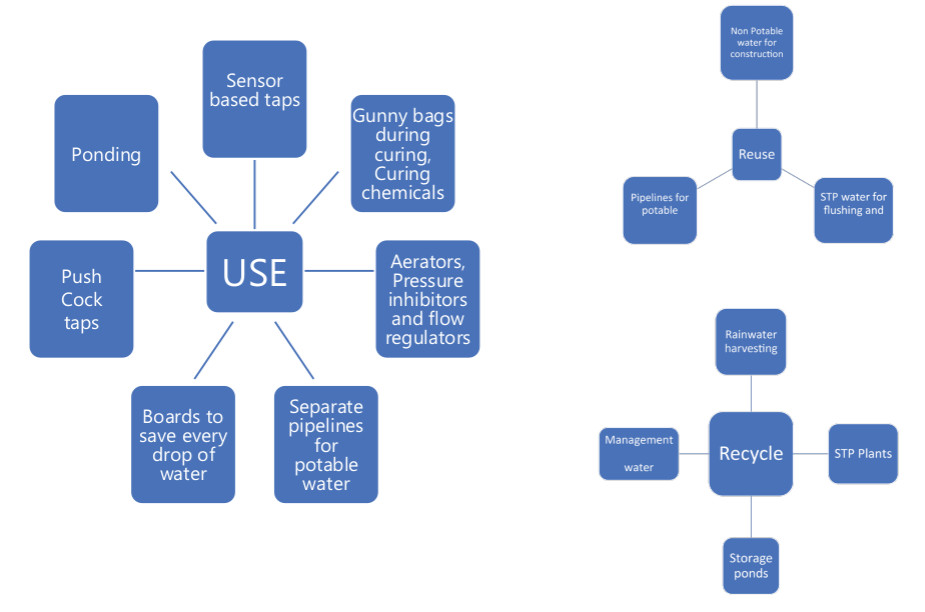
Sensitization and conservation: training about water conservation:
Nitte (DU) undertakes sustained campaigns to encourage students and staff to save water on campus. Modules on environmental sustainability, including water conservation, are included in the formal curriculum of most programs. The National Service Scheme volunteers conduct campaigns to raise awareness about water conservation
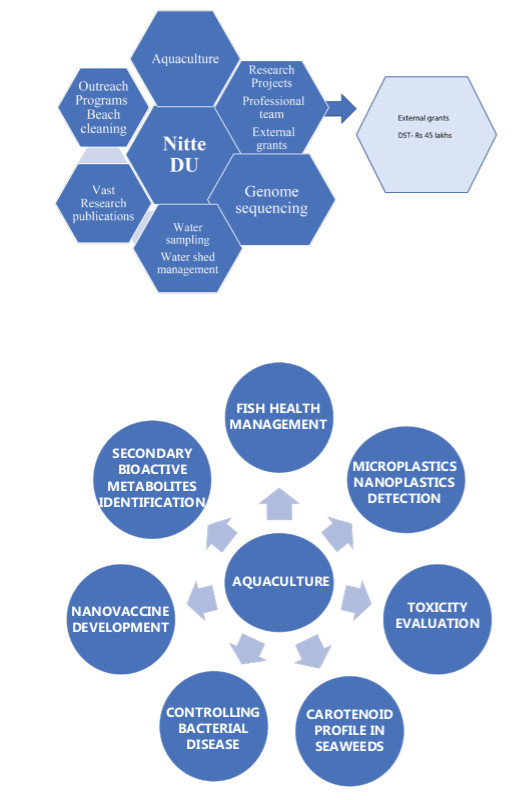
Research activities at Nitte (DU)
Aquaculture and fish health management Identifying appropriate probiotics to control the disease burden in aquaculture Marine fishery resources have once been thought to be renewable and replenishable. Due to anthropogenic activity and over-exploitation of marine resources, the resources tend to be depleting, and some marine fish cannot replenish. The concern to meet human demand and the failure to satisfy the demand through fishing bought the bloom concept of aquaculture. The aquaculture practices become greedy as demand increases and intern introduced to many stresses induced pathogens due to overstocking. In turn, the farmers adopted an early and easy solution to eradicate fish pathogens through antibiotics which in the long term posed impacts on aquaculture practices by developing antibiotic- resistant pathogens. The overwhelming demand for fisheries and fish resources is increasing daily, along with the pathogen number increasing in the culture system resulting in fish culture failure and considerable losses to the farmers due to high morbidity and mortality. All these problems made farmers and scientists look for natural sources to eradicate pathogen and antibiotic resistance problems in fish culture systems, which gave rise to the concept of probiotics. Probiotics are any living organisms that, when administered in adequate amounts, can colonize the gut system and produce beneficial effects on the host. The host may be human, fish, or other terrestrial or marine animals. In this study, we can isolate the probiotics from the host, ensuring there is less host rejection when applied on the field. The gut flora will remain the same after applying probiotics to the fish. The primary goal is to isolate and see its effect against the fish pathogens encountered routinely in the culture system, destroying the fish seeds by bringing mass mortality and morbidity. The isolated probiotics were checked for their ability to inhibit fish pathogens in-vitro. The colonization efficacy inside the gut system of zebrafish will be checked to see if it can colonize and produce its good effects to the host by eliminating fish pathogen and aiding in survivability. The probiotics will be checked for their ability to produce various digestive enzymes that can boost the feed conversion ratio and feed utilization rate by hydrolyzing micro food nutrients. The study will bring changes in the therapeutic approaches in the fish culture systems. Probiotics can be a better alternative to the antibiotics currently being used without the standard procedures resulting in mass antibiotic resistance problems in fish cultures. Since the probiotics can also hydrolyze food constituents, that helps the feed conversion ratio (feed to body weight) and feed utilization rate will reduce the burden on the fish farmer by reducing expenditure on the feed. Since isolated probiotics can produce spores, the probiotics can be formulated through feed and stored in dry conditions until it is practically applied and there is a chance of commercialization. Above all, it will not affect natural flora and fauna, as antibiotic treatments can show these effects.
Application of bacteriophage to control bacterial disease in aquaculture:
Aeromonas has been one of the pathogenic genera causing significant economic losses in aquaculture. Control diseases caused by this pathogen; antibiotics are often preferred. However, antibiotics sensitivity decreases over time and reduces the efficiency of the treatment. Hence other methods must be developed to control such diseases in aquaculture. These methods should reduce the risk of developing and spreading microbial resistance and be economically affordable and environmentally friendly. Phage therapy is an eco-friendly alternative to prevent and control pathogenic bacteria. In this study, the in-vivo efficacy of phage was determined to control Aeromonas infection in freshwater fish using zebrafish as a model. Aeromonas-free zebrafish larvae were prepared by treating embryos with antibiotics and disinfectants. These germ-free embryos were used to study host-pathogen interaction, and the efficacy of phages in reducing bacterial growth and thus supporting larval survival was demonstrated. A collection of phages that are active against virulent A. hydrophila is established. Field trials with the collection would establish its sustainable use as a biocontrol mechanism in aquaculture.
Next-generation vaccine (nanovaccine) development for fish health management:
The potential of modern biotechnology has not been unleashed in the field of aquaculture. This study intends to use biotechnology as a platform for new approaches and solutions to disease control and prevention in aquaculture and to develop vaccines based on genus- specific antigens from Aeromonas hydrophila, which could protect bacterial genera. Progressive developments in nanotechnology have unlocked new approaches to producing more potent vaccines. The nano-formulations can be prepared using poly lactic-co-glycolic acid (PLGA). Nanovaccines have several benefits over conventional vaccines. The nanoparticles serve as a potential vehicle for vaccine delivery. In aquaculture, oral administration is a more convenient and economical way to achieve antigen. Delivery since it eliminates the laborious and tedious injection technique. For this purpose, nanoparticles protect the antigens from degradative enzymes and provide a sustained release. Due to the smaller size of the particle, it can be very efficient in triggering cellular and humoral immune responses. To date, no vaccines against A.hydrophila are commercially available, and Aeromonas remains a leading cause of mortality and morbidity in the Indian aquaculture; hence this study will give the insight to help in identifying novel and immunogenic OMPs of A.hydrophila to develop a suitable oral vaccine using PLGA as a carrier system to control aeromonads disease in aquaculture.
Identification of secondary bioactive metabolites from mud crab:
Secondary bioactive metabolites such as non- ribosomal peptides (NRPs) and polyketides (PKs) were detected in the gut microbiome of green mud crab Scylla serrata. After the PCR detection of biosynthetic genes in the bacteria, the positive isolates were PCR amplified, followed by gene sequencing. The sequences were subjected to in-silico analysis. The antimicrobial biosynthetic gene clusters such as NRPS and PKS in the bacterial strains isolated from the intestine of mud crab S.serrata show their biosynthetic potential. Since the isolates detected positive for biosynthetic gene clusters, the antimicrobial properties of those bacterial strains should be analyzed for their antagonistic activity against pathogenic microbes.
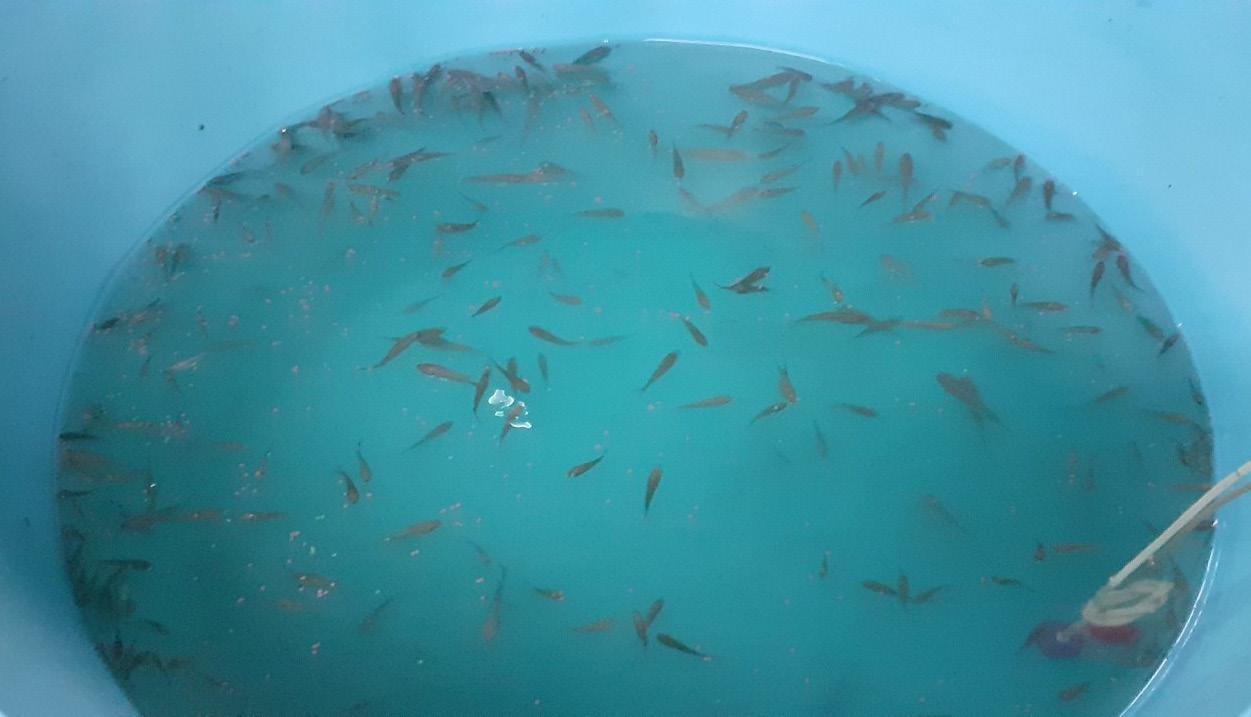
Release of fish in grow out tank
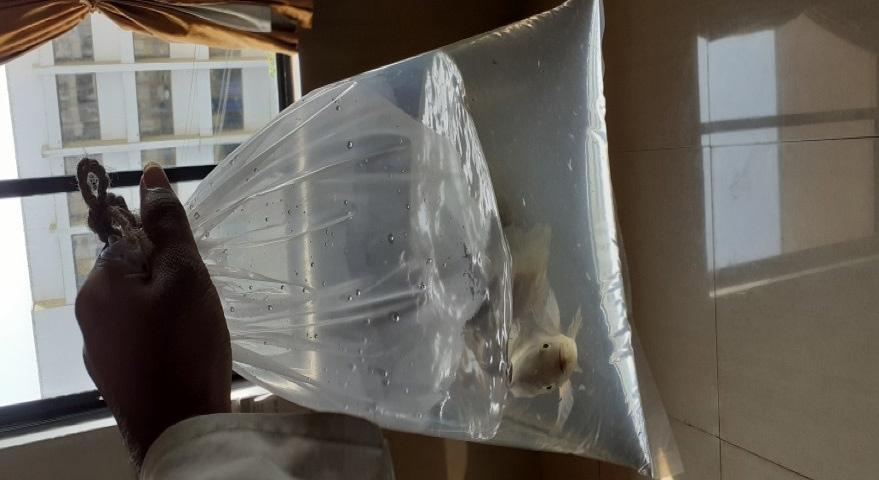
Microplastics in seafoods and its trophic transfer:
Plastic is being seen as a global threat due to its non-biodegradable properties and improper disposal. The increased production of plastic has led to its accumulation in either landfills or aquatic systems. Due to the ever-growing plastic pollution, the terms “Microplastics” and “nano plastics” have gained a lot of popularity and attention. Hence, majority of aquatic environments have been shown to contain these synthetic remains of plastic, which account for a sizable fraction of environmental Microplastics (MPs). However, they seem to be underrepresented in MP ecotoxicity research. The problem of MPs prompted us to design the current investigation to find MPs in the commonly consumed fishes and check their transfer between the organisms. To study the occurrence of MPs, 160 fish samples were collected from local vendors in and around the coastal area of India Mangalore.
Forty seafood samples were collected, which local people commonly consumed, like Clams, and the other fish samples were the Indian Mackerel, Sole fish and Shrimp. MPs from the gills and gut of the fish were identified by FTIR analysis. The MP polymers detected were Polyethylene (PE), Polypropylene (PP), Polystyrene (PS), Polyethylene terephthalates (PET) and Polyvinylchloride (PVC). The most abundant type of polymer detected in seafood was found to be PE, followed by PS. Interestingly, many MPs sink to the bottom of the ocean and the study shows that there is a high uptake of MPs by bottom dwellers such as sole fish and clams.
Furthermore, the interaction of MPs with organisms and their trophic transfer was determined using invertebrate (brine shrimps) and vertebrate (zebrafish) model systems. This study has shown that MPs enter biological systems and are retained in the GIT of organisms. The MPs at varying concentrations of 100 p/L, 1000 p/L and 10000 p/L were taken up by
shrimps and zebrafish, with an estimated 29 and 214 particles reported in these organisms, respectively. Therefore, direct and indirect trophic transfer of MPs were observed in Artemia and Zebra fish, with MPs retained in zebra fish GIT reported to be 2.13%. Moreover, higher reactive oxygen species levels were observed in groups exposed to MPs compared to control groups. This study convincingly showed the increased presence of MPs in seafood, which may pose potential hazards to human health and trigger inflammatory diseases such as inflammatory bowel or asthma. It indicated that over a long period, the accumulation of MPs occurs in each successive trophic level. The higher organism tends to consume a large amount of readily available biomass to sustain their energy needs; in this process, they consume higher levels of MPs from lower organisms that have previously been either directly (from the environment) or indirectly (by consuming other organisms) exposed to MPs.
Drug resistance bacteria form a biofilm to survive in the hospital effluent:
The presence of biofilm-forming bacteria in wastewater treatment is a major problem world. The study implies that biofilm acts as machinery for bacteria to survive in the hospital effluent, an antibiotic stress environment. Hospital wastewater is a major reservoir for antibiotic-resistant bacteria, including NDM- 1-carrying isolates. The presence of NDM 1 genes in transmissible elements among the bacteria constitutes a noteworthy risk due to its horizontal spread to the other bacteria. Treating the hospital waste water is imperative before releasing it into the surrounding environment. The study stresses the need for stringent antibiotic use and efficient wastewater treatment policies in hospital settings, which is paramount in achieving sustainable health. Hospital effluents act as a conducive medium for antibiotic-resistant bacteria, a significant health threat. Plasmid encoding NDM-1 isolates were selectively reduced in the final effluent after the wastewater treatment. The risk can be minimized by following proper wastewater treatment policies in these settings
Molecular characterization of Legionella pneumophila and related species in Mangaluru:
Legionella, a genus of Gram-negative bacteria common in soil and aquatic systems, is a new- age pathogen. However, because Legionella infections are challenging to identify, the number of cases caused by other Legionella species remains unknown. Legionella pneumophila causes community and hospital-acquired pneumonia. The main route of infection is the inhalation of contaminated aerosols. Since there is no vaccine for the disease, prevention is the recommended first line of defence. Though Legionella is considered a problem in developed countries, the World Health Organization considers it underestimated in developing countries. Rapid detection and indicators would be critical to screening this group of bacteria. Although sporadic cases of Legionellosis have been reported in India, the prevalence of this infection is still underestimated. Legionella is a common pathogen and is ubiquitous; however, the global prevalence of Legionellosis is still unknown. This study was undertaken to determine the prevalence of Legionella pneumophila and related species in coastal Karnataka since this information is unavailable. Additionally, the study examined specific indicators that could be used to predict this organism’s presence.
Prevalence and Characterization of Legionella pneumophila and related species from water- based recreational sites:
Legionella is a genus of Gram-negative bacteria common in soil and aquatic systems and is associated with protists. The present study aims at phenotypic and molecular identification of
Legionella in water and swab samples collected from water-based recreational sites. The biofilm- forming ability of Legionella on exposure to various temperatures and iron concentrations was also studied. Out of thirty water and swab samples tested, one from a garden sprinkler and swimming pool and one from both water and swab samples from a decorative fountain showed the presence of Legionella. A biofilm study of Legionella categorized the bacteria as a moderate biofilm former. The present study revealed that most of the water and swab samples were negative for Legionella, which is quite encouraging. Decontamination techniques and proper hygienic practices can reduce the contamination of water systems in recreational facilities.
Toxicity evaluation of synthetic compound using zebrafish model system:
Environmental health and consequences of toxicant exposure are emerging as an essential public health issue as manufacturing processes, and the production of new synthetic compounds increase to keep up with the expanding global demand. This has generated a vital need for toxin surveillance, identification of exposure consequences, and understanding of the biological, chemical, and genetic mechanisms underlying those effects. Chemical pesticides play a vital role in solving food problems. There is no doubt that heterocyclic structures are an essential feature in synthetic pesticides for their high efficiency, various biological activities and diversity of possible substituents. 1,2,4-Oxadiazole heterocycle, an essential five- membered oxygen-nitrogen heterocycle, has exhibited a wide range of biological activities in the field of pesticides, such as insecticidal, antifungal, and herbicidal activities. Zebrafish are commonly used as a model organisms for toxicological studies. The study showed adverse and harmful effects of oxadiazole during exposure to zebrafish embryos, even at a lower concentration.
Detection of microplastics in water and toxicity evaluation using zebrafish:
The terms microplastic and nano plastics have become very common and attracting a lot of attention due to ever-increasing plastic pollution in all forms of the environment. Thereby leading to many studies on its detection and effects on organism health, including humans using various model systems. In this study, Nile red (NR) stain was used to detect the presence of microplastics in bottled water and open source. A total of sixty bottles from 20 different brands stored in three conditions were analyzed. Microplastics were abundant in all samples of water, mainly fragments (80%) and fibres (20%). FTIR analysis of both bottled and open water showed the availability of polyethene, polystyrene, polypropylene and polyamide. Polyethylene and polystyrene were the most commonly observed polymers in bottles of water. Therefore, these two polymers aware considered for further study to understand their effects on organisms’ health. Further evaluations on the effects of the polymers in a zebrafish model system to understand their potential risk to human health will give better insight to focus future research in this area and fill knowledge gaps.
Evaluation of microplastic-induced oxidative stress in zebrafish:
Microplastics (MPs) have become a prevalent environmental pollutant in freshwater and marine ecosystems. Polyethylene was the most observed polymer in bottles of water. Therefore, polyethylene polymer was considered for further study in the zebrafish model system. Polyethylene microplastics ((Fluorescent tagged Polyethylene 10-90 um) at a concentration of 100 ppm, 500 ppm, and 1000 ppm exposed zebrafish embryos showed severe morphological defects with increasing concentrations of microplastics. Redox imbalance analysis of the PE-exposed zebrafish demonstrates increased ROS activity at 100 ppm, 500 ppm, and 1000 ppm concentrations at 48 hpf. The gene expression of first-line antioxidative defence markers SOD2 and CAT showed significant downregulation in the exposed embryo at 100ppm, 500 ppm, and 1000 ppm at 24 hpf and 120 hpf. These findings suggest that concentration, time-dependent toxicity, and oxidative stress could be the critical effects of microplastic on human health.
Detection of micro and nanoplastics in bottled water and evaluation of the associated health effects using the zebrafish model system:
The terms microplastic and nano plastics have become very common and getting a lot of attention due to ever-increasing plastic pollution in all forms of the environment. In this study, Nile red (NR) stain was used to detect the presence of microplastics in bottled water and open source. A total of sixty bottles from 20 different brands stored in three conditions were analyzed. Microplastics were abundant in all samples of water, mainly fragments and fibres. FTIR analysis of both bottled and open water showed the availability of polyethylene, polystyrene, polypropylene and polyamide. Polyethylene and polystyrene were the most commonly observed polymers in bottles of water. Therefore, these two polymers aware considered for further study to understand their effects on organisms’ health.
Carotenoid profile of seaweeds of Dakshina Kannada district:
With the distressing consequences of day-to-day lifestyle practices, there is a change in the trend in people’s outlook from synthetic medicine to natural therapeutics leading to higher demand for natural supplements. Carotenoids are one such class of pigments with excellent bioactive properties that are being studied extensively. This study’s main focus was analyzing the carotenoid profile of locally found seaweeds of Dakshina Kannada district in India to understand their potential of use as an alternative source for commercial extraction of carotenoids. A total of 14 seaweeds, including Chlorophyta, Rhodophyta, and Phaeophyceae, were collected from the coastal belt of Mangaluru from selected representative stations. Xanthophyll carotenoids and provitamin-A carotenes were estimated, and the former was found to be major pigments among the collected seaweeds. Results revealed the total carotenoid content in the order; of Chlorophyta > Rhodophyta > Phaeophyceae. Lutein is one such xanthophyll carotenoid with antioxidant, anti-cancerous and anti- inflammatory properties. Among the macroalgae analyzed, Cladophora sp. and Grateloupia sp. have the highest amount of lutein. Fucoxanthin is another prominent xanthophyll carotenoid extracted from seaweeds and has anti-obesity, anti-tumour and antioxidant properties. The major sources of fucoxanthin include Sargassum wightii and Padina tetrostomatica.
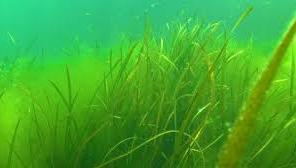
Cladophora Sp.
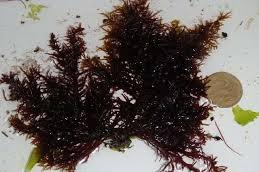
Grateloupia Sp.
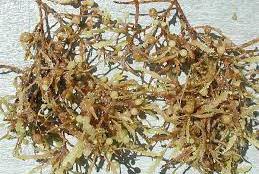
Sargassum wightii
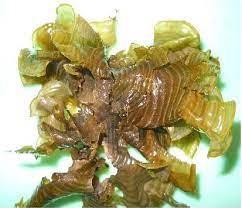
Padina tetrostomatica
Isolation and characterization of bioactive peptides from ribbon fish :
Fish is a nutritious food source of protein. Fish species are a crucial part of the diet, with lower cholesterol levels than animal-derived food. It is also a good source of vitamins and minerals, including iron and zinc. Greater research interest in finding new and safe bioactive compounds from natural sources for their use in foods and medicinal materials as synthetic replacer compound is of recent interest. Fish muscle, skin, bone, and internal organs are presently utilized to isolate several bioactive materials, such as collagen, gelatine, bioactive peptides, minerals, and polyunsaturated fatty acids. Recently bioprocessing technologies have been developed to isolate, characterize, and utilize these natural bioactive peptides from fish. Enzyme technology is one of the best methods to isolate the bioactive compounds from fish and fish parts. The enzymatically isolated peptides have good bioactive properties like antihypertensive, antioxidant, antimicrobial, antithrombic, and antidiabetic activity. The study on isolated bioactive peptides from ribbon fish showed a promising antihypertensive property which can be explored for its application in functional food combating hypertension.
Water sampling
All students, employees and visitors in the centres of Nitte (DU) have free access to clean drinking water. Drinking water is available through UV-based water purifier dispensers. The quality of water is assessed periodically through both in-house and external testing. The quality of the various water sources, including drinking water available on the University campus, is periodically sampled and tested for various chemical and microbial parameters. This contributes to a healthy campus. All major buildings have separate storage facilities for potable and non-potable water. Segregated storage tanks and pipelines are available for potable water, stormwater and grey water.
Water Recycling
Use of recycled water for gardening and toilet flushing purposes. The wastewater is collected and treated in Sewage Treatment Plants (STP). Three campuses have individual STPs. The KSHEMA campus has an STP plant with a handling capacity of 4,00,000 litres/day. University and Hospital campuses have a plant of 8,00,000 litres/day, and the Paneer campus has a plant handling 2,50,000 litres/day.
Watershed management system at Paneer:
The whole water supply network data is collected by GPS survey. The Nitte village has eighteen water sources with sixteen bore-wells and two water tanks to supply water 12,000 populations. All of these sources are connected through branches of network to supply drinking water to consumer. This was carried out through Network Mapping of Drinking Water Supply at Nitte Village Panchayath, Udupi using Global Positioning System (GPS). Further information of this project is available in this doi:10.13140/ RG.2.2.20685.74725
International collaboration ondisease prevention in aquaculture:
Nitte (DU) is involved through an ongoing research project with the Norwegian University of Life Science, Oslo, to explore biotechnological approaches to prevent and control fish disease in aquaculture (BIOAQUA). This ongoing project has been financially supported by the Department of Science & Technology (DST), Government of India, with a budget of Rs. 45 lakhs. The aim is to promote scientific renewal and development of disciplines and/or to generate new knowledge about issues relevant to both societies in mutually agreed fields and to achieve bilateral world-class scientific results in the field of bioeconomy.
Research on the Defence genes of Tiger shrimps (Penaeus monodon) concerning bacteria (Vibrio harveyi) and white spot syndrome virus (WSSV) infection is undertaken by Prof. Indrani Karunasagar in collaboration with Prof Peter Bossier of Ghent University
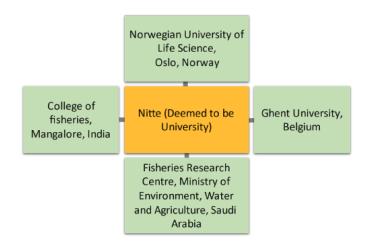
Student involvement in nurturing aquatic ecosystem conservation:
The students of the Department of Public Health, KSHEMA, have developed a short video titled “Jala” to observe World Water Day on 22nd March 2021
https://youtu.be/to67lWQQSJ8
As a part of the Swachh Bharath Mission, Adhyetha, the Alumni Association of NUCSER, organized a beach clean-up session on Sunday, 28th February 2021, at Someshwar Beach, Mangaluru. A team of 30 volunteers, including faculty members, joined hands in cleaning up a stretch of the most popular area of the beach. The team collected trash from the beach and the parking areas, and plastic items contributed the most. It was a productive Sunday morning, where the participants transformed the beach into a more clean and beautiful one. The team also came up with a few eco-friendly tips for everyone to follow to reduce the pollution in our oceans. The tips included - opting for ice cream cones instead of cups to reduce the use of plastic spoons and cups, going for e-bills instead of customer copies while swiping cards, going for refills instead of single-use pens, leaving the ends of packed chips, cookies, milk packets hanging rather than cutting it off, to reduce plastic pollution, drinking the tender coconut directly instead of using straws.
http://aboutnitte.blogspot.com/ search?q=A+beach+clean-up+session
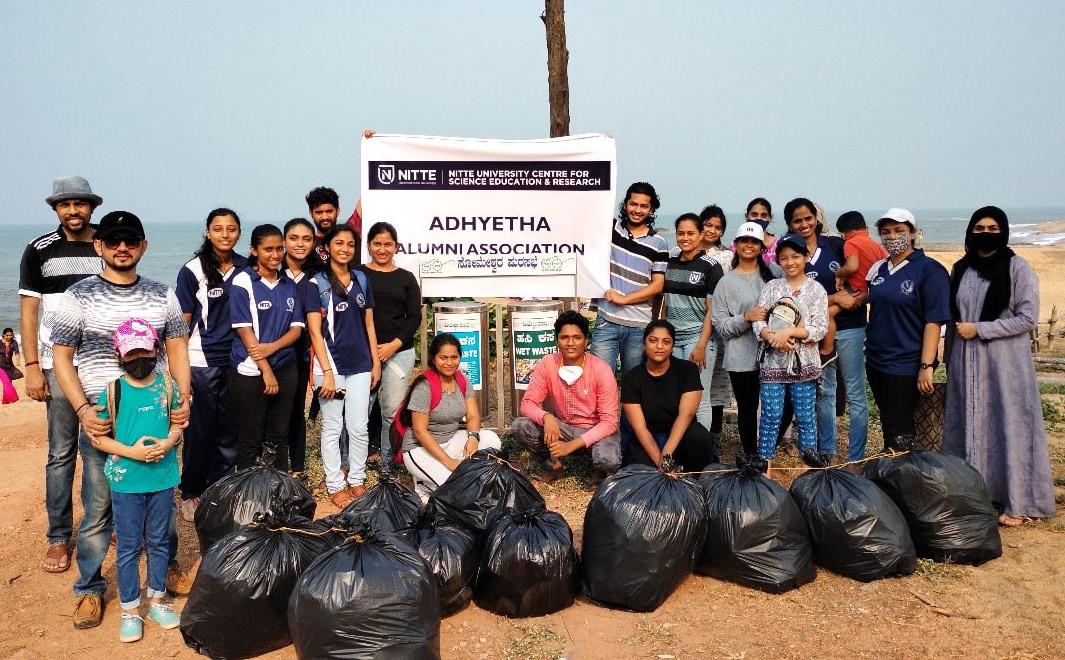
Nitte (DU) incorporates modules to educate the faculty and students. More projects on life underwater will be undertaken by the robust research team working on life underwater.
Research publications of 2021:
- Rajeish M, Dechamma MM, Mani MK, Rai P, Karunasagar I, Bossier P, Karunasagar I, Maiti B. Different expression pattern of thrombospondin gene in the presence and absence of β-glucan fed Penaeus monodon challenged with white spot syndrome virus. Fish and Shellfish Immunology Reports.2021 Dec: 2:100020
- Puneeth, Akhila DS, Dechamma M M, Santhosh SK, Girish SK, Venugopal MN Protective efficacy of recombinant wsy477 protein against white spot syndrome virus infections in Shrimp, Penaeus monodon. Indian Journal of Fisheries, 2021 Sept; 68(4): 76-81 Prithvisagar KS, Krishna Kumar B, Kodama T, Rai P, Iida T, Karunasagar I, Karunasagar I. Whole genome analysis unveils genetic diversity and potential virulence determinants in Vibrio parahaemolyticus associated with disease outbreak among cultured Litopenaeus vannamei (Pacific white shrimp) in India. Virulence.2021 Aug; 12(1):1936-49.
- Dubey S, Maiti B, Girisha SK, Das R, Lamkhannat M, Mutoloki S, Chen SC, Karunasagar I, Evensen Ø. Aeromonas species obtained from different farmed aquatic species in India and Taiwan show high phenotypic relatedness despite species diversity. BMC Research Notes.2021 Aug 16; 14(1):313
- Yathish U.G, Iddya Karunasagar, Mamatha BS. Bioactivity and functional properties of protein hydrolysate from muscle and visceral waste of ribbonfish (Lepturacanthus savala) extracted by three different proteolytic enzymes, Journal of Biologically Active Products from Nature. 2021 Aug;11 (4): 363 – 379
- Naveen Kumar S, Rai P, Karunasagar I, Karunasagar I. Recombinant viral proteins delivered orally through inactivated bacterial cells induce protection in Macrobrachium rosenbergii (de Man) against White Tail Disease. Journal of Fish Diseases.2021 May; 44(5):601-612
- Apine E, Rai P, Mani MK, Subramanian V, Karunasagar I, Godhe A, Turner LM. Comparative analysis of the intestinal bacterial communities in mud crab Scylla serrata in South India. MicrobiologyOpen. 2021 April ;10(2): e1179 Bhat I, Haripriya G, Jogi N, Mamatha BS. Carotenoid composition of locally found seaweeds of Dakshina Kannada district in India. Algal Research. 2021 March; 53(7): 102154
- Rajeish M, Mani MK, Dechamma MM, Bossier P, Rai P, Karunasagar I, Maiti B. Expression profile of heat shock protein 70 in lymphoid organs of Penaeus monodon in response to white spot syndrome virus infection. Aquaculture Research.2021 Mar; 52(3):1316- 20.
- Kulkarni A, Krishnan S, Anand D, Kokkattunivarthil Uthaman S, Otta SK, Karunasagar I, Kooloth Valappil R. Immune responses and immunoprotection in crustaceans with special reference to Shrimp. Reviews in Aquaculture. 2021 Jan;13(1):431- 459
- Anupama KP, Nayak A, Karunasagar I, Karunasagar I, Maiti B. Evaluation of loop- mediated isothermal amplification assay along with conventional and real-time PCR assay for sensitive detection of pathogenic Vibrio parahaemolyticus from seafood sample without enrichment. Molecular Biology Reports.2021 Jan; 48(1):1009-1016.
- Maiti, B, Chakraborty, A, Karunasagar, I. Biotechnological advances in the development of outer membrane protein- based vaccines for use in aquaculture. In: Biotechnological Advances in Aquaculture Health Management. Giri, SS and Gupta, SK (Eds.). First edition. Chapter 3. Springer Nature, Singapore.2021; Pg No.43-59. ISBN: 978-981-16-5194-6
- Ashwath P, Premanath R, Dharnappa Sannejal A, Tammisetti VN, Gupta SK, Alla DR. Metagenomic Approaches to Identify Fish Gut Microbiome and the Effect of Prebiotic Supplements on Gut Microbes and Health Management. In: Biotechnological Advances in Aquaculture Health Management 2021 (pp. 431-458). Springer, Singapore. 978-981- 16-5194-6
- Kaur-Kahlon, G., Kumar, B.K., Ruwandeepika, H.A., Defoirdt, T. and Karunasagar, I., 2021. Quorum Sensing Regulation of Virulence Gene Expression in Vibrio harveyi during its Interaction with Marine Diatom Skeletonema marinoi. Journal of Pure and Applied Microbiology, 15(4), pp.2507-2519.
- Vittal R, Mohan Raj JR, Kumar, B.K. and Karunasagar, I. Advances in Environmental Detection and Clinical Diagnostic Tests for Legionella species. Journal of Health and Allied Sciences NU. 2021 DOI https://doi. org/10.1055/s-0041-1731863
- Vittal R, Mohan Raj JR, Kumar BK, Karunasagar I Iron Content as an Indicator for Legionella Species in Artificial Water Systems. Medico- Legal Updates.2021;21:803-8.


.png)